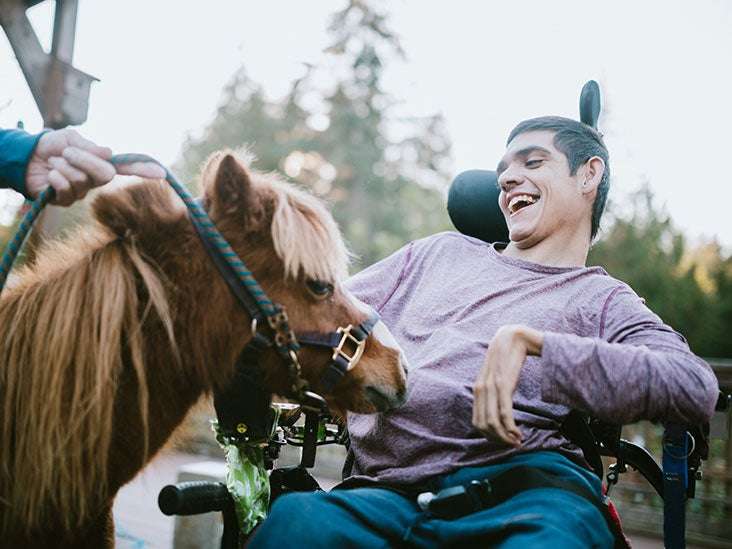Animal therapy or pet therapy refers to the use of animals as a way to help people cope with and recover from some physical and mental health conditions.
Depending on the function of the therapy, people may choose from various animals, including dogs, horses, and birds. Animal assisted therapy is not the only therapeutic option in most cases, but it can be a good choice for some people.
Keep reading to learn more, including how it works, who it may benefit, and more.
What is it?

Share on Pinterest
Interacting with professionally trained dogs, horses, and birds may help people with physical or mental health conditions.
Animal therapy, also called pet therapy or animal assisted therapy, refers to various services using animals to help people with specific physical or mental health conditions.
Animals may be able to provide comfort, alert others if someone is in danger, or even perform direct actions to help a person’s condition when they are in need. It is a type of complementary or alternative therapy. It should enhance but not replace other treatments.
On the whole, the goal of animal assisted therapy is to alleviate or help people cope with some symptoms of various conditions where possible.
The exact type of animal therapy can vary greatly depending on what condition the person has, the type of animal, and what kind of therapy they provide.
Animal therapy builds on a concept called the human-animal bond, which describes people’s desire to interact with and relate to animals. For many people, by interacting with a friendly animal, they can form a bond with them. This bond can produce a calming state in the person.
This bond itself may help the person in several ways, such as:
- reducing boredom
- increasing movement and activity through walks and play
- providing companionship and decreasing loneliness
- increasing social interactions
- improving mood and general well-being
The positive interactions with an animal may lead to benefits in the mind and body, such as reduced stress and an overall more balanced mental and emotional state.
Animal therapy partially uses this bond in a directed way to achieve the goals of the therapy.
How does it work?
Animal therapy can have several goals, and these will determine how it works. The type of therapy and target for this therapy may change depending on the condition and the type of aid that a person needs. Some examples include:
- providing comfort and reducing levels of pain
- improving movement or motor skills
- developing social or behavioral skills
- increasing motivation toward activities such as exercise or interacting with others
The process of animal therapy itself typically involves the animal’s handler, who is often the owner, bringing the animal to each session. The handler will work under a doctor’s guidance to help the person achieve the goals of their therapy.
A number of organizations train handlers and connect them to healthcare providers. Many handlers work as volunteers. Before getting approval for therapy use, both the animal and the handler will have to go through various certifications with these groups and organizations.
The handler must generally pass an instructional course on how to interact with people and perform the types of therapies that they may provide.
The animal also has to go through certain checks. These will include checking immunization records and performing physical exams to ensure that the animal is generally healthy and free of disease. They will also have to undergo temperament testing to make sure that they behave properly with both the handler and other people.
Additionally, the pair will go through obedience training. This rigorous testing and certification ensures the safety and professionalism of everyone involved and helps give the person access to the best therapy sessions possible.
It is important to note that a therapy dog is not the same as a service dog and does not have all of the same rights. For example, a therapy dog cannot accompany a handler into a business establishment.
Who might benefit?
Animal therapy may help people with a range of health issues.
Mental health
The Pet Partners organization note that these therapies may improve many important markers of stress and disorder by:
- decreasing anxiety and stress
- decreasing perceptions of pain
- reducing feelings of fear or worry
- increasing feelings of social support
- providing motivation, stimulation, and focus
A review study notes that animal therapy appears to provide general benefits for both physical and psychological health. Evidence for animal assisted therapy appears strongest for markers of anxiety and depression in the widest range of people.
The researchers note that the therapy may be beneficial for people from many different age groups with various conditions. For example, a 2019 study found that the use of therapy dogs improved the efficacy of mental health treatments among adolescents.
Together, these factors may make the therapy helpful for aspects of conditions such as:
- dementia
- depression
- anxiety
- autism spectrum disorder
- attention deficit hyperactivity disorder (ADHD)
- schizophrenia
Studies involving the use of therapy horses and dogs have shown that animal therapy might also help alleviate the symptoms of post-traumatic stress disorder (PTSD).
Some people going through rehabilitation for a drug use disorder may also respond well and have a greater sense of well-being when working with an animal.
Physical health
Some forms of animal therapy may also help with markers of physical conditions, including:
- epilepsy
- heart failure
- pain from cancer treatment
- postoperative recovery
- recovery after a major stroke or another condition that causes a person to lose motor skills
Working with an animal in these cases may motivate the person to continue therapy, boost their mood, and reduce signs of pain. For physical conditions, it may help them move correctly and exercise often.
Additionally, some long-term care facilities may offer pet therapy programs to help improve the mood and general well-being of people in these facilities.
A study in Psychogeriatrics found that dog assisted therapy in long-term elderly care facilities helped reduce symptoms of depression. The research suggests that the dogs help facilitate social interaction and create positive emotional responses.
However, more research is necessary to confirm the benefits of animal therapy.
Risks
While animal therapy may be helpful for people with certain health issues, it may not be right for everyone.
Some people may be allergic to the animals that commonly play a role in therapy. Many people are allergic to the dander from a dog’s shedding, for example. For these individuals, animal therapy with a dog could cause far more harm than good.
Others may simply be uncomfortable with or afraid of the animals. They may not choose this type of therapy as it would cause them more stress.
In some cases, a person may become very attached to the animal rather quickly. This feeling could lead to possessiveness or actually decrease a person’s satisfaction with therapy.
Additionally, therapy animals that visit hospitals and other long-term facilities may be carriers of certain infections or diseases. There may be a chance of them spreading these infections to other people, making thorough testing important for any animal.
Alternatives
Animal therapy is a complementary treatment. It is not a basis for the treatment of any condition and should only enhance or complement other treatment. It is not a replacement for other forms of therapy, such as psychotherapy or physical therapy.
This form of therapy might not suit everyone, however. People who do not respond well to animal therapy or are not interested in trying it may ask about other options. These alternatives will vary depending on the person’s condition.
Learn more about several types of therapy options here.
Summary
Animal therapy involves regular sessions with professionally trained animals and their handlers. It aims to help people cope with both physical and mental health disorders.
Doctors or mental health specialists may recommend and administer animal therapy for various conditions, with different goals in mind for each person.
Some people may not enjoy animal therapy or have other reasons to avoid it, and they can choose from alternative therapies.
Anyone considering animal therapy should discuss the process and how they may benefit from it with a doctor or mental health specialist.
 Animal-assisted therapies (AAT) are approaches to mental health care that incorporate animals into the psychotherapy process, emphasizing the bond created during human-animal interactions. Emotional recovery and positive psychological transformation often occurs when the relationship between an individual and the therapy animal grows.
Animal-assisted therapies (AAT) are approaches to mental health care that incorporate animals into the psychotherapy process, emphasizing the bond created during human-animal interactions. Emotional recovery and positive psychological transformation often occurs when the relationship between an individual and the therapy animal grows.
Professionals often advocate for using animals in psychotherapy treatment because animals can bring forth a vivid array of nurturing emotions, and many people seeking help respond positively to the idea of caring for another being.
How Can Animal-Assisted Therapies Help?
Animal-assisted psychotherapy can provide numerous psychological and physiological benefits. People who interact with animals for the purpose of therapy may experience improvements in health, including:
- Decreased stress levels
- Reduced anger and aggression
- Decreased hostility toward the self and others
- Improved social interactions
- Decreased heart rate and blood pressure
- Rise in release of beta-endorphins
- Improvement in self-esteem, patience, and trust
- Sense of empowerment
Find a Therapist
Advanced Search
Improved mood and reduced anxiety tend to be consistent results with AAT. Individuals who perceive hostility or disregard from other humans may come to accept the nonjudgmental and unconditional affection and attention from an animal, instead. Studies of AAT demonstrate these results in nearly all participants, regardless of age, the duration of the session, or the severity of symptoms.
Animal-assisted therapy has been proven to be beneficial not only for the human individuals involved, but also the animals. Each being experiences positive results from the attention received from the other, according to studies between horses and humans and between humans and dogs.
Types of Animal-Assisted Psychotherapy
Professionals administering or overseeing AAT might work with any type of animal, depending on the preferences and personal needs of a person in therapy.
Animals that might serve in a therapy capacity include, but are not limited to horses, dogs, dolphins, fish, birds, and small pet rodents such as rats or hamsters.
Some therapies, such as dolphin-assisted therapy, have mixed results. While unlikely to be harmful, they may or may not produce desired therapeutic benefits and should be further researched to determine their long-term effects. Others, such as equine therapy, have a wealth of research supporting their positive impact on recipients’ mental health.
Organizations offering AAT might give participants a variety of animals to choose from by operating on a large farm or creating a type of petting zoo filled with AAT-approved animals. As long as a mental health professional is involved in the psychotherapy process and the animal participant(s) is trained or approved for use as a therapy animal, the specifics of AAT can be determined by the therapist and person receiving therapy.
Some residential treatment centers are organized around long-term AAT, offering a camp-like environment, programs for nature immersion, animal training sessions, and other opportunities. Some are focused on a particular aspect of mental health. Grief camps, for example, offer children who have experienced personal loss the opportunity to work through emotional experiences with horses or dogs.
Owning a therapy or companion animal, such as a dog trained to sense and alleviate anxiety, is only loosely considered a type of animal-assisted psychotherapy. AAT, by definition, involves the active participation of a mental health professional. Studies that evaluate the benefits of AAT generally do not include evidence gathered from this particular population.
Animal-Assisted Therapy for All Ages
People of any age can see benefits from interacting with animals in a psychotherapy setting. Young children often see dramatic improvements in interpersonal relationships with equine-assisted therapy. For example, young children who are unable to express physical and emotional comfort and closeness with others, or find it difficult to do so, may more readily form that type of bond with a horse or other animal.
This unique bond can help the child develop traits like patience, respect, empathy, acceptance, confidence, assertiveness, and responsibility. The unspoken communication between child and animal can foster verbal and nonverbal communication skills in the child. All of these attributes help children maintain secure and mutually respectful relationships during difficult times throughout their lives.
Studies have shown animal-assisted psychotherapy also has a positive impact on aging individuals and the elderly. AAT can be especially effective for people who used to have dogs or other animals but are no longer able to care for their own animal. Being in the presence of pets again can help remind people of the love they had for previous animals, stirring memories and reducing loneliness.
Concerns and Limitations
A wide variety of animals can assist individuals in psychotherapy, and some may need to exercise caution around some animals. For example, horses can pose significant dangers due to their weight and size, especially for children. Some people may experience allergies to some animals or their environments, such as dogs, horses, and hay.
Consult a physician if you have any health conditions that might affect or complicate an experience with animal-assisted psychotherapy. As always, collaborate with your mental health professional to select an animal-assisted modality that will provide the most benefit and lead to positive emotional progress.
References:
- Banks, M. R., & Banks, W. A. (2002). The effects of animal-assisted therapy on loneliness in an elderly population in long-term care facilities. The Journals of Gerontology Series A: Biological Sciences and Medical Sciences, 57(7), M428-M432. Retrieved from https://academic.oup.com/biomedgerontology/article/57/7/M428/553460
- Barker, S. B. (1999). Therapeutic aspects of the human-companion animal interaction. Psychiatric Times, 16(2), 45-46. Retrieved from http://citeseerx.ist.psu.edu/viewdoc/download?doi=10.1.1.730.8607&rep=rep1&type=pdf
- Barker, S. B., & Dawson, K. S. (1998). The effects of animal-assisted therapy on anxiety ratings of hospitalized psychiatric patients. Psychiatric Services, 49(6), 797-801. Retrieved from http://ps.psychiatryonline.org/doi/abs/10.1176/ps.49.6.797
- Hallberg, L. (2008). Walking the way of the horse: Exploring the power of the horse-human relationship. Bloomington, IN: iUniverse.
- Humphries, T. L. (2003). Effectiveness of dolphin-assisted therapy as a behavioral intervention for young children with disabilities. Bridges, 1(6), 1-9. Retrieved from http://www.waterplanetusa.com/images/Effectiveness_of_Dolphin_Assisted_Therapy.pdf
- Marino, L., & Lilienfeld, S. O. (2007). Dolphin-assisted therapy: More flawed data and more flawed conclusions. Anthrozoös, 20(3), 239-249. Retrieved from http://www.tandfonline.com/doi/abs/10.2752/089279307X224782
- Martin, F., & Farnum, J. (2002). Animal-assisted therapy for children with pervasive developmental disorders. Western Journal of Nursing Research, 24(6), 657-670. Retrieved from http://journals.sagepub.com/doi/abs/10.1177/019394502320555403
- Nimer, J., & Lundahl, B. (2007). Animal-assisted therapy: A meta-analysis. Anthrozoös, 20(3), 225-238. Retrieved from http://www.tandfonline.com/doi/abs/10.2752/089279307X224773
- Odendaal, J. S. (2000). Animal-assisted therapy—magic or medicine? Journal of Psychosomatic Research, 49(4), 275-280. Retrieved from http://www.sciencedirect.com/science/article/pii/S0022399900001835




